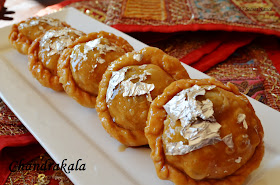Any of the festival is incomplete without sweets in India. From north to south, east to west, every region has their speciality. Today I am making a north Indian ladoo made with khoya and til (sesame seed). The best part is thats its really quick and you can have this on any vrat/fasting.
Khoa/Khoya (also khoo-wah) is a milk food widely used in Indian and Pakistani cuisine, made of either dried whole milk or milk thickened by heating in an open iron pan.It is similar to ricotta cheese, but lower in moisture and made from whole milk instead of whey.There are three types of khoya - batti, chickna, and daanedaar. Batti, meaning “rock,” has 50% moisture by weight and is the hardest of the three types; it can be grated like cheese. It can be aged for up to a year, during which it develops a unique aroma and a mouldy outer surface. Chickna (“slippery” or “squishy”) khoya has 80% moisture. For daanedaar, the milk is coagulated with an acid during the simmering; it has moderate moisture content. Different types of khoya are used for different preparations. (Source: wikipedia)
This recipe can be made in form of ladoo or barfi as you and your family like it to eat.
Serve: Makes 15 ladoos
Preparation time: 30 minutes
Ingredients:
Til/ Sesame Seed: 1-½ cups Roasted (1 cup crushed)
Almonds & Pistas: 2 tbsp (chopped)
Sugar to taste: Powdered
Khoya: 2 cups
Cashew nut for garnish
Method:
1) Roast khoya on low flame till it turns light golden-yellow in color. Allow it to cool for a few minutes.
2) Now add roasted crushed and roasted whole sesame seeds (til) to roasted khoya and mix it well.
3) Add powdered sugar to the above mixture when it is lukewarm. Add chopped nuts.
4) Mix well and shape the mixture into small balls. Avoid too hot mixture so as to prevent the melting away of sugar.
5) Arrange the ladoos in a plate and garnish them with cashew nuts.
6) Til-Khoya Ladoo is ready to serve. You can store it in airtight container and keep it in fridge. It can be easily stored for 15-20 days.
BON APPETIT...
Khoa/Khoya (also khoo-wah) is a milk food widely used in Indian and Pakistani cuisine, made of either dried whole milk or milk thickened by heating in an open iron pan.It is similar to ricotta cheese, but lower in moisture and made from whole milk instead of whey.There are three types of khoya - batti, chickna, and daanedaar. Batti, meaning “rock,” has 50% moisture by weight and is the hardest of the three types; it can be grated like cheese. It can be aged for up to a year, during which it develops a unique aroma and a mouldy outer surface. Chickna (“slippery” or “squishy”) khoya has 80% moisture. For daanedaar, the milk is coagulated with an acid during the simmering; it has moderate moisture content. Different types of khoya are used for different preparations. (Source: wikipedia)
This recipe can be made in form of ladoo or barfi as you and your family like it to eat.
Serve: Makes 15 ladoos
Preparation time: 30 minutes
Ingredients:
Til/ Sesame Seed: 1-½ cups Roasted (1 cup crushed)
Almonds & Pistas: 2 tbsp (chopped)
Sugar to taste: Powdered
Khoya: 2 cups
Cashew nut for garnish
Method:
1) Roast khoya on low flame till it turns light golden-yellow in color. Allow it to cool for a few minutes.
2) Now add roasted crushed and roasted whole sesame seeds (til) to roasted khoya and mix it well.
3) Add powdered sugar to the above mixture when it is lukewarm. Add chopped nuts.
4) Mix well and shape the mixture into small balls. Avoid too hot mixture so as to prevent the melting away of sugar.
5) Arrange the ladoos in a plate and garnish them with cashew nuts.
6) Til-Khoya Ladoo is ready to serve. You can store it in airtight container and keep it in fridge. It can be easily stored for 15-20 days.
BON APPETIT...



















